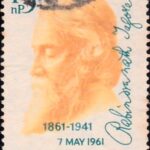
Abanindranath Tagore
A commemorative postage stamp on the Birth Centenary of Abanindranath Thakur, an Indian Bengali artist, promoted Contextual Modernism, founder of Indian Society of Oriental Art, a nephew of Rabindranath Tagore :

 Issued by India
Issued by India
Issued on Aug 7, 1971
Issued for : The Posts and Telegraphs Department feel privileged in commemorating the birth centenary of Abanindranath Tagore by bringing out a stamp depicting one of his creations.
The painting chosen for this purpose is titled “Abhisarika” and purports to illustrate a verse in Kalidasa‘s ‘Ritu Samhara.’ Although the painting is one of the earliest attempts on the part of the artist, to present an Indian theme in the so called Indian style, it echoes influences of techniques of western art also. The lady in the picture dressed in a sari with pleated folds and transparent scarf revealing a fair complexion denotes sensuous beauty par excellence, while the evocative gestures, mood and the elegant pose suggest gentle movement and subtle restlessness.
Description of Design : The design of the stamp is vertical and depicts one of the well known paintings “Abhisarika” of the artist Abanindranath Tagore.
Type : Stamp, Mint Condition
Colour : Suede Grey & Chestnut
Denomination : 20 Paise
Overall Size : 4.06 X 2.28 cms.
Printing Size : 3.80 X 2.0 cms.
Perforation : 14½ x 14
Watermark : Printed on unwatermarked adhesive stamp paper
Number Printed : 30,00,000
Number per issue sheet : 50
Printing Process : Photogravure
Designed and Printed at : India Security Press
Name : Abanindranath Tagore
Born on Aug 7, 1871 at Jorasanko, Kolkata, India
Died on Dec 5, 1951 at Kolkata, India
About :
- Abanindranath Tagore was born on August 7, 1871 at Jorasanko, the Tagore residence at Calcutta in a family where creative activity was very natural. Some of his early impressionable years were spent at Champdani in an old house by the river side. Here Abanindranath began to draw and paint. After his father’s death, the family returned to Calcutta where Abanindranath spent some years at the Sanskrit College where he developed a love for Indian classics. He also studied music and later started to have tuition in art. The earlier training as an artist of Abanindranath was under two European teachers working in the then Calcutta Art School. At that stage, the artistic mind of Abanindranath was following a routine course, conditioned by the 19th century art ideal. But very soon, the discerning eye of the artist in him found out some strange affinity between the two art trends – one the indigenous and the other foreign. Born out of this new feeling Abanindranath created a new series of Radha-Krishna paintings, which represent the artist’s earlier attempts to paint Indian pictures in the Indian manner. It was during this period, Abanindranath became acquainted with E. B. Havell who was instrumental in appointing Abanindranath as the Vice-Principal of the then Calcutta School of Arts. Through Okakura, the famous Japanese connoisseur, Abanindranath got an opportunity to know and understand the art and culture of China and Japan.
- Abanindranath was not a traveller, but his few journeys to Monghyr, Puri and Konark and Darjeeling have had very memorable results. Some of the more well known of the artist’s creations are Uma (c. 1921), Bharat Mata (1902), Omar Khyam Series (c. 1906-8) and Arabian Nights Series (1930). In his later years, Abanindranath took to a new activity ‘creation of small toys‘, art works of sculpture made from found objects. Nand Lal Bose, Kshitindranath Majumdar and K. Venkatappa are among those who were inspired by Abanindranath, whose position in modern Indian Art is in many ways unique, comparable to that of Rabindranath Tagore in the realm of letters. Among the written works of Abanindranath are Shadanga (Six Limbs of Painting) and Bharata Silpa. Abanindranath died in 1951.








[…] one may trace its origin to the earlier years of the century against the chequered backdrop of Abanindranath Tagore and the Indian renaissance, Ravi Varma and his like – the academic realists in the Western […]
[…] him enrol at the College of Art, Calcutta in 1905. He was fortunate to receive the guidance from Abanindranath Tagore who, at that time, was the Vice-Principal. While studying in the College of Art, he won a […]
[…] Haldar, a pioneer of the Renaissance School of Indian Painting and a distinguished disciple of Abanindra Nath Tagore was born in Calcutta in 1890. As a child he owed his first inspiration to his grandfather, […]
[…] the death of its founder in 1941, Visva-Bharati had a difficult period for sometime. Abanindranath Tagore, the renowned artist, held the reins of the institution for some years, in spite of his failing […]
[…] family of Bengal were among the pioneers of the Indian Renaissance at the turn of this century. Abanindranath and Gaganendranath, nephews of the great Poet Tagore, gave expression to the new awakening in the […]
[…] joined the Calcutta Art School in 1905 when Abanindranath Tagore was its Vice-Principal. His association with the Tagores greatly influenced his early life. He […]